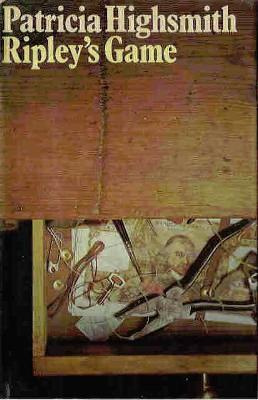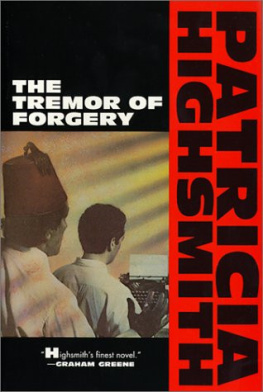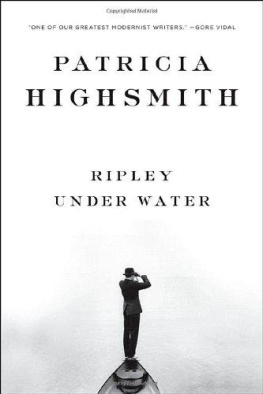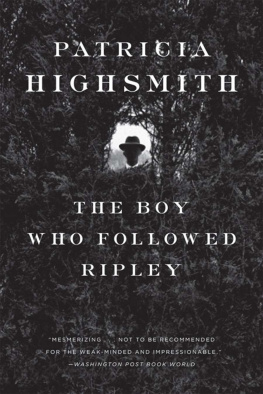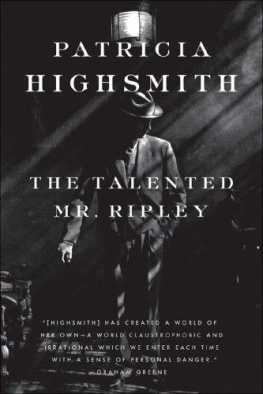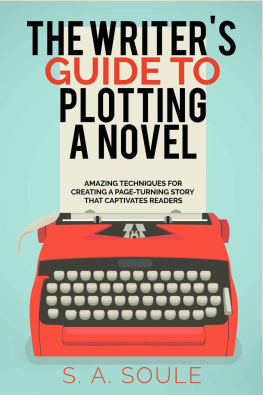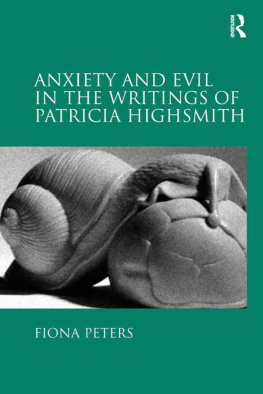Patricia Highsmith - Plotting and Writing Suspense Fiction
Here you can read online Patricia Highsmith - Plotting and Writing Suspense Fiction full text of the book (entire story) in english for free. Download pdf and epub, get meaning, cover and reviews about this ebook. year: 1983, publisher: ePubLibre, genre: Art. Description of the work, (preface) as well as reviews are available. Best literature library LitArk.com created for fans of good reading and offers a wide selection of genres:
Romance novel
Science fiction
Adventure
Detective
Science
History
Home and family
Prose
Art
Politics
Computer
Non-fiction
Religion
Business
Children
Humor
Choose a favorite category and find really read worthwhile books. Enjoy immersion in the world of imagination, feel the emotions of the characters or learn something new for yourself, make an fascinating discovery.
- Book:Plotting and Writing Suspense Fiction
- Author:
- Publisher:ePubLibre
- Genre:
- Year:1983
- Rating:4 / 5
- Favourites:Add to favourites
- Your mark:
- 80
- 1
- 2
- 3
- 4
- 5
Plotting and Writing Suspense Fiction: summary, description and annotation
We offer to read an annotation, description, summary or preface (depends on what the author of the book "Plotting and Writing Suspense Fiction" wrote himself). If you haven't found the necessary information about the book — write in the comments, we will try to find it.
Patricia Highsmith: author's other books
Who wrote Plotting and Writing Suspense Fiction? Find out the surname, the name of the author of the book and a list of all author's works by series.
Plotting and Writing Suspense Fiction — read online for free the complete book (whole text) full work
Below is the text of the book, divided by pages. System saving the place of the last page read, allows you to conveniently read the book "Plotting and Writing Suspense Fiction" online for free, without having to search again every time where you left off. Put a bookmark, and you can go to the page where you finished reading at any time.
Font size:
Interval:
Bookmark:

Patricia Highsmith, author of Strangers On a Train, The Talented Mr. Ripley, Found In The Street, and many other books, is known as one of the finest suspense novelists. In this book, she analyzes the key elements of suspense fiction, drawing upon her own experience in four decades as a working writer. She talks about, among other topics; how to develop a complete story from an idea; what makes a plot gripping; the use (and abuse) of coincidence; characterization and the likeable criminal; going from first draft to final draft; and writing the suspense short story.
Throughout the book, Highsmith illustrates her points with plentiful examples from her own work, and by discussing her own inspirations, false starts, dead ends, successes, and failures, she presents a lively and highly readable picture of the novelist at work.
Anyone who wishes to write crime and suspense fiction, or who enjoys reading it, will find this book an insightful guide to the craft and art of a modern master.

Patricia Highsmith
ePub r1.0
Titivillus 02.07.18
Ttulo original: Plotting and Writing Suspense Fiction
Patricia Highsmith, 1983
Editor digital: Titivillus
ePub base r1.2


PATRICIA HIGHSMITH (1921-1995) was born in Fort Worth, Texas, and moved to New York when she was six, where she attended the Julia Richman High School and Barnard College. In her senior year she edited the college magazine, having decided at the age of sixteen to become a writer. Her first novel, Strangers on a Train, was made into a classic film by Alfred Hitchcock in 1951. The Talented Mr Ripley, published in 1955, introduced the fascinating anti-hero Tom Ripley, and was made into an Oscar-winning film in 1999 by Anthony Minghella. Graham Greene called Patricia Highsmith the poet of apprehension, saying that she created a world of her own a world claustrophobic and irrational which we enter each time with a sense of personal danger and The Times named her no.1 in their list of the greatest ever crime writers. Patricia Highsmith died in Locarno, Switzerland, in February 1995. Her last novel, Small g: A Summer Idyll, was published posthumously, the same year.
THE GERM OF AN IDEA
THE first person you should think of pleasing, in writing a book, is yourself. If you can amuse yourself for the length of time it takes to write a book, the publishers and the readers can and will come later.
Every story with a beginning, middle, and end has suspense; a suspense story presumably has it more so. In this book I shall use the word suspense in the way the book trade uses it, as meaning stories with a threat of violent physical action and danger, or the danger and action itself. Another characteristic of the suspense story is that it provides entertainment in a lively and usually superficial sense. One does not expect profound thought or long sections without action in a suspense story. But the beauty of the suspense genre is that a writer can write profound thoughts and have some sections without physical action if he wishes to, because the framework is an essentially lively story. Crime and Punishment is a splendid example of this. Infact, I think most of Dostoyevskys books would be called suspense books, were they being published today for the first time. But he would be asked to cut, because of production costs.
Developing story germs
What is the germ of an idea? It is probably all things to all writers: A child falling on a sidewalk and spilling his ice cream cone. A respectable-looking man in a grocers surreptitiously but as if under a compulsion pocketing a ripe pear without paying for it. Or it can be a brief sequence of action that pops into the head out of nowhere, from nothing seen or heard. Most of my germinal ideas are of the last type. For instance, the germ of the plot for Strangers on a Train was: Two people agree to murder each others enemy, thus permitting a perfect alibi to be established. The germinal idea for another book, The Blunderer, was not so promising, was more stubborn about developing, but showed a hardihood by sticking in my head for more than a year, and nagging at me until I found a way to write it. This was: Two crimes are strikingly similar, though the people who commit them do not know each other. This idea would not interest many writers, I think. It is a so what idea. It needs embellishments and complications. In the book that resulted, I had the first crime done by a more or less cool killer, the second by an amateur attempting to copy the first, because he thinks the first killer has gotten away with his crime. Indeed, the first man would have, if not for the blundering effort of the second man to imitate him. And the second man did not even go through with his crime, only went to a certain point, a point at which the similarity was striking enough to attract the attention of a police detective. Thus a so what idea may have its variations.
Some story ideas never develop by parthenogenetic method, but need a second idea to get them going. One such ineffectual story germ was the original of This Sweet Sickness: A man wants to cash in on the old insurance game, insuring himself, then apparently dying or disappearing, and finally collecting. There must be some way, I thought, to give this idea a new twist, to make it fresh and fascinating in a new kind of story. I labored over this for weeks in my evening hours. I wanted to have my criminal-hero set himself up in a different house with a different name, a house into which he could move permanently when his real self was presumably dead and gone. But the idea did not come to life. One day the second one appeared in this case a far better motive than I had thought of until then, a love motive. The man was creating his second house for the girl he loved but never won, as the story turned out. He was not interested in insurance or money, because he had money. He was a man obsessed with his emotion. I wrote in my notebook under all my fruitless notes: All the above is rot, and proceeded to work on my new line of thought. Everything came suddenly alive. It was a splendid feeling.
The writers imagination
Another story that needed two story germs to come alive was The Terrapin, a short story which won a Mystery Writers of America award and has since been anthologized. The first germ came from a story a friend told me about someone she knew. One does not expect such stories to be fertile germs, because they are not ones own. The most exciting story told by a friend with the fatal remark, I know you can make a terrific story out of this, is pretty sure to be of no value to the writer whatever. If its a story, its already a story. It doesnt need a writers imagination, and his imagination and brain reject it artistically, as his flesh would reject the grafting of someone elses flesh upon it. A famous anecdote about Henry James relates that when a friend started to tell him a story, James stopped him after a very few words. James had heard enough, and preferred to let his imagination do the rest.
Font size:
Interval:
Bookmark:
Similar books «Plotting and Writing Suspense Fiction»
Look at similar books to Plotting and Writing Suspense Fiction. We have selected literature similar in name and meaning in the hope of providing readers with more options to find new, interesting, not yet read works.
Discussion, reviews of the book Plotting and Writing Suspense Fiction and just readers' own opinions. Leave your comments, write what you think about the work, its meaning or the main characters. Specify what exactly you liked and what you didn't like, and why you think so.


